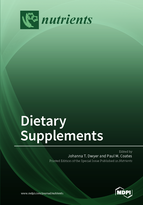Dietary Supplements
A special issue of Nutrients (ISSN 2072-6643).
Deadline for manuscript submissions: closed (31 August 2017) | Viewed by 342549
Special Issue Editors
Interests: health effects of nutrients and other bioactives; human clinical trials; motivations for and prevalence of use of dietary supplements; biomarkers of intake and nutritional status; databases of dietary supplements
Interests: systematic reviews; public health nutrition
Special Issue Information
Dear Colleagues,
We invite you to contribute to a Special Issue of Nutrients, entitled “Dietary Supplements”. The purpose of this Special Issue is to advance dietary supplement science by presenting commissioned overviews on four nutrients of particular current interest and controversy: Vitamin D, iodine, iron, and omega-3 fatty acids. To supplement these contributions, we welcome the submission of manuscripts describing original research, or that provide systematic reviews that relate to several issues in dietary supplement science. Manuscripts across a broad range of topics will be considered, but we are particularly interested in considering manuscripts that address the following areas:
- Health effects, both positive and negative, of single nutrients, such as vitamin D, iodine, iron, and omega-3 fatty acids, with an emphasis on human studies.
- Human clinical trials of dietary supplement use
- Motivations for and prevalence of use of dietary supplements
- Mechanisms of action of nutrients and other bioactive components of dietary supplements.
- Biomarkers of nutritional status, especially those measured in human samples.
- Development and application of analytical tools for the measurement of bioactive components of dietary supplements.
- Databases of dietary supplement composition for use in improving the assessment of nutrient intake and exposures to ingredients in these products in human populations.
Dr. Johanna T. Dwyer
Dr. Paul M. Coates
Guest Editors
Manuscript Submission Information
Manuscripts should be submitted online at www.mdpi.com by registering and logging in to this website. Once you are registered, click here to go to the submission form. Manuscripts can be submitted until the deadline. All submissions that pass pre-check are peer-reviewed. Accepted papers will be published continuously in the journal (as soon as accepted) and will be listed together on the special issue website. Research articles, review articles as well as short communications are invited. For planned papers, a title and short abstract (about 100 words) can be sent to the Editorial Office for announcement on this website.
Submitted manuscripts should not have been published previously, nor be under consideration for publication elsewhere (except conference proceedings papers). All manuscripts are thoroughly refereed through a single-blind peer-review process. A guide for authors and other relevant information for submission of manuscripts is available on the Instructions for Authors page. Nutrients is an international peer-reviewed open access semimonthly journal published by MDPI.
Please visit the Instructions for Authors page before submitting a manuscript. The Article Processing Charge (APC) for publication in this open access journal is 2900 CHF (Swiss Francs). Submitted papers should be well formatted and use good English. Authors may use MDPI's English editing service prior to publication or during author revisions.
Keywords
- dietary supplements
- food supplements
- vitamin D
- iodine
- iron
- omega-3 fatty acids
- micronutrients
- bioactives
- ingredients
- databases
- health outcomes
- biomarkers







